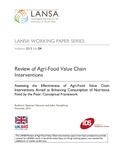| dc.contributor.author | Henson, Spencer | |
| dc.contributor.author | Humphrey, John | |
| dc.coverage.spatial | Bangladesh | en |
| dc.coverage.spatial | India | en |
| dc.coverage.spatial | Pakistan | en |
| dc.date.accessioned | 2016-08-15T16:08:15Z | |
| dc.date.available | 2016-08-15T16:08:15Z | |
| dc.date.issued | 2015-12 | |
| dc.identifier.citation | Henson, S. and Humphrey, J. (2015) Assessing the Effectiveness of Agri-Food Value Chain Interventions Aimed at Enhancing Consumption of Nutritious Food by the Poor: Conceptual Framework, LANSA Working Paper Series 4. Brighton: LANSA. | en |
| dc.identifier.uri | https://opendocs.ids.ac.uk/opendocs/handle/20.500.12413/12162 | |
| dc.description.abstract | South Asia has experienced rapid economic growth, yet it still has the highest rate of child malnutrition in the world, and half the population is undernourished. Besides children, undernutrition among women and adolescent girls is also a major concern. The lack of progress in solving undernutrition, in all its guises, reflects in part the complexity of factors involved.
There is increasing interest in the links between agriculture and nutrition outcomes in consumers who derive some or all of their food through markets. Seeing that many households rely on food purchases for all or part of their nutrient intake, attention is being given to the scope for developing and improving the functionality of agri-food value chains for better nutrition. Also, many households in South Asia rely on market purchases seasonally or year round, for some or all of their dietary needs. For these people, access to food depends upon how the food markets function.
This paper lays out a conceptual framework to guide the analysis of value chain-based interventions aimed at enhancing the intake of micronutrient-dense foods in South Asia under the LANSA research programme. It describes in broad detail how this framework is employed to undertake a series of case studies of value chain-based interventions aimed at increasing consumption of nutrient-dense foods in Bangladesh, India and Pakistan. The conceptual framework specifically focuses on understanding the effectiveness of interventions in enhancing the performance of food markets in terms of the availability, affordability, acceptability and consumption of nutritious foods by the poor on a sustained basis, with particular emphasis on infants and women of child-bearing age. The ultimate aim is to identify the most effective strategies for ensuring that nutritious foods get to the poor and are eaten and draw lessons that can inform policy in the region. | en |
| dc.description.sponsorship | UK Aid | en |
| dc.description.sponsorship | Department for International Development (DFID) | en |
| dc.language.iso | en | en |
| dc.publisher | Leveraging Agriculture for Nutrition in South Asia (LANSA) | en |
| dc.relation.ispartofseries | LANSA Working Paper Series;4 | |
| dc.rights.uri | http://creativecommons.org/licenses/by-nc-nd/4.0/ | en |
| dc.subject | Economic Development | en |
| dc.subject | Health | en |
| dc.subject | Nutrition | en |
| dc.subject | Poverty | en |
| dc.title | Assessing the Effectiveness of Agri-Food Value Chain Interventions Aimed at Enhancing Consumption of Nutritious Food by the Poor: Conceptual Framework | en |
| dc.title.alternative | Review of Agri-Food Value Chain Interventions | en |
| dc.type | Series paper (non-IDS) | en |
| dc.rights.holder | ©Leveraging Agriculture for Nutrition in South Asia (LANSA) | en |
| dcterms.dateAccepted | 2015-12 | |
| rioxxterms.funder | Department for International Development, UK Government | |
| rioxxterms.identifier.project | LANSA | |
| rioxxterms.version | NA | en |
| rioxxterms.funder.project | 752f8189-3789-4438-be29-585edbe66660 | |


